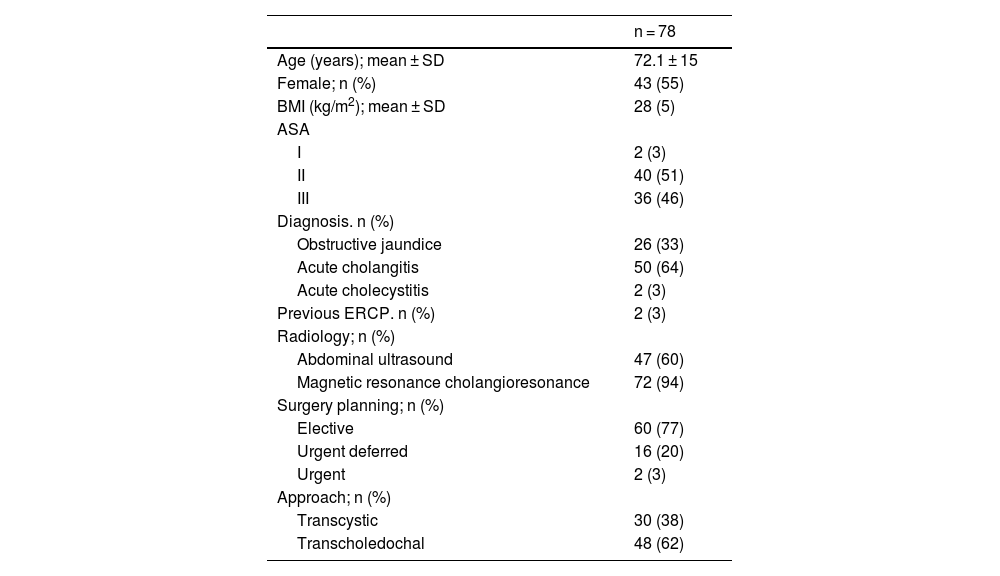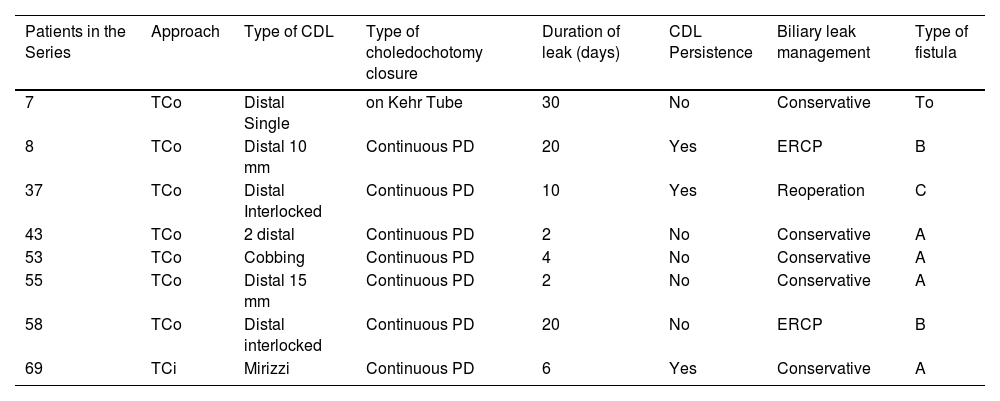To analyze the results obtained in terms of efficacy and safety during the learning curve of a surgical team in the technique of laparoscopic common bile duct exploration with cholecystectomy (LCBDE+LC) using choledochoscopy for the treatment of patients with cholelithiasis and choledocolithiasis or common bile duct stones (CBDS) (CDL).
MethodsSingle-center prospective analysis of patients treated with LCBDE+LC during the first 4 years of implementation of the technique. A descriptive and comparative analysis was carried out between groups according to the transcystic (TCi) or transcolecocal (TCo) approach, and also evolutionary by periods. The effectiveness of the technique was evaluated using the variable success rate and safety through the analysis of the overall complication rate and the bile leak rate as the most frequent adverse effect.
ResultsA total of 78 patients were analyzed. The most frequent approach was TCo (62%). The overall success rate was 92%. The TCi group had a shorter operating time, a lower overall complications rate and a shorter hospital stay. The TCo approach was related to a higher rate of clinically relevant bile leak (8%). Complex cases increased significantly during the learning curve without effect on the overall results.
ConclusionsLCBDE+LC is an effective and safe technique during the learning curve. Its results are comparable to those published by more experienced groups and do not present significant differences related to the evolution during learning period.
Analizar los resultados obtenidos en términos de eficacia y seguridad durante la curva de aprendizaje (CA) de un equipo quirúrgico en la técnica de exploración laparoscópica de la vía biliar con colecistectomía (ELVB + CL) mediante coledocoscopia para el tratamiento de pacientes con colelitiasis y coledocolitiasis (CDL) concomitantes.
MétodosAnálisis prospectivo unicéntrico de los pacientes intervenidos mediante ELVB + CL durante los 4 primeros años de implementación de la técnica. Se realizó un análisis descriptivo, comparativo entre grupos según abordaje transcístico (TCi) o transcolecocal (TCo) y evolutivo por períodos. Se evaluó la eficacia de la técnica mediante la variable “tasa de éxito” y la seguridad mediante la “tasa de complicaciones globales” y la “tasa de fuga biliar” como efecto adverso más frecuente.
ResultadosSe analizaron un total de 78 pacientes. El abordaje más frecuente fue el TCo (62%). La tasa de éxito global fue del 92%. El grupo TCi presentó menor tiempo operatorio, menor tasa de complicaciones globales y menor estancia hospitalaria media. El abordaje TCo se relacionó con una mayor tasa de fuga biliar clínicamente relevante (8%). Durante la CA se incrementaron significativamente los casos complejos sin efecto sobre los resultados globales.
ConclusionesLa implementación de la ELVB + CL se demuestra eficaz y segura durante la CA. Sus resultados son equiparables a los publicados por grupos de mayor experiencia y no presentan diferencias significativas relacionadas con la evolución durante dicho período.















